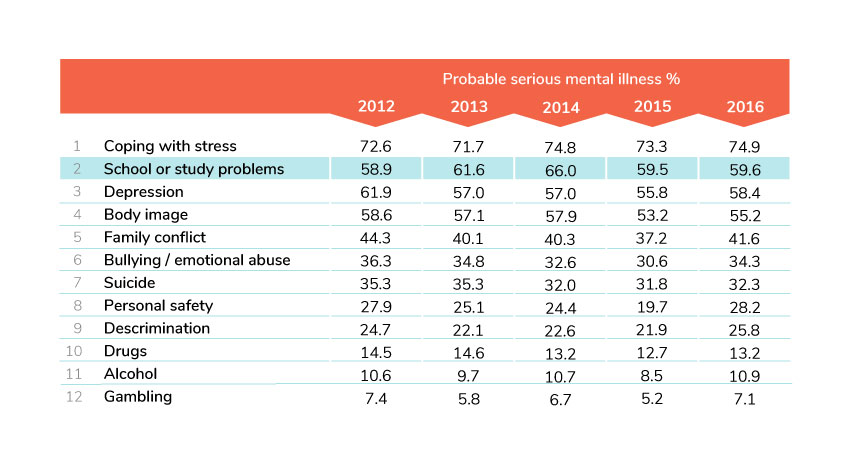Below are our findings that form the evidence base to commence our work and will support the exploration of new solutions.
Every young Australian, regardless of where they live or what school they attend should be recognised through a learning system that helps them thrive.
EDUCATIONAL GOALS
Australia has identified two goals for a fit-for-purpose, national education system;
Firstly, that it promotes equity and excellence, and, secondly, that all young Australians become confident and creative individuals, successful lifelong learners, and active and informed members of the community1.
CURRENT MEASURES OF SUCCESS
How we define and measure success in learning is too narrow. It is limiting young people’s ability to prepare for their future which flows through to Australia’s workforce participation and productivity.
Current forms of assessment (such as the ATAR, secondary school certificates, or VET qualifications) privilege some forms of learning over others.
Young people develop capabilities from diverse life experiences inside and outside of the classroom but because many of these capabilities are not measured or credentialled by Australia’s formal schooling system they are not recognised or visible to recruiters and employers.
1 in 3
75%
63%
Discover more
Assessment is vital for good learning but we need to recognise the broader capabilities that students possess.
Broader capabilities can be developed inside the classroom, but are also developed outside the classroom through activities such as workplace experience, participation in sport and hobbies, or engagement within the community. These capabilities could provide a stronger indication of the drive and potential of a young person.
“The systemic shift toward school improvement appears to have led to an undue emphasis on academic outcomes, such as ATAR scores, rather than an overall view of what students have learned, know and can achieve as individuals. For example, the current presentation of the Senior Secondary Certificate of Education (SSCE) tends to outline only a student’s grades, rather than providing a broader picture of their skills, capabilities and maturity. A student’s workplace experience and community engagement may help provide a much better indication of their drive, resilience and developmental potential.”
© State of Victoria (Department of Education and Training)
By only measuring or valuing how well a student performs in a subject area through assessment we are missing out on the opportunity to showcase the knowledge they have gained and their ability to learn.
By way of example, the ATAR ranks students against their peers, but misses the broader picture of what a young person has learnt or has achieved.
If young people were able to articulate their skills and have their capabilities recognised this could help them with the transition from full time education to full-time work. This is crucial with unemployment rates for young people at 13.8%5, significantly higher compared to other age groups.
THE CHANGE WE NEED
There is no consistent way to measure or reflect the instances where young people are successfully learning the skills and qualities they and Australia needs into the future, that is recognised at the system level.
Despite many great attempts to address some of the challenges in the current education system, we haven’t seen the transformational change we need.
EQUITY & EXCELLENCE
Too many young people who experience barriers to learning are falling behind because our current way of measuring success is not enabling or recognising their skills and contributions.
In particular, we are seeing this in the ways outlined below:
FIGURE 1: Year 12 retention rates of young people living with disability
Young people aged 20-24 who are living with disability are less likely to complete year 12 or equivalent (64%) compared to those without a disability (81%).11
Year 12 retention rates of young people living with disability
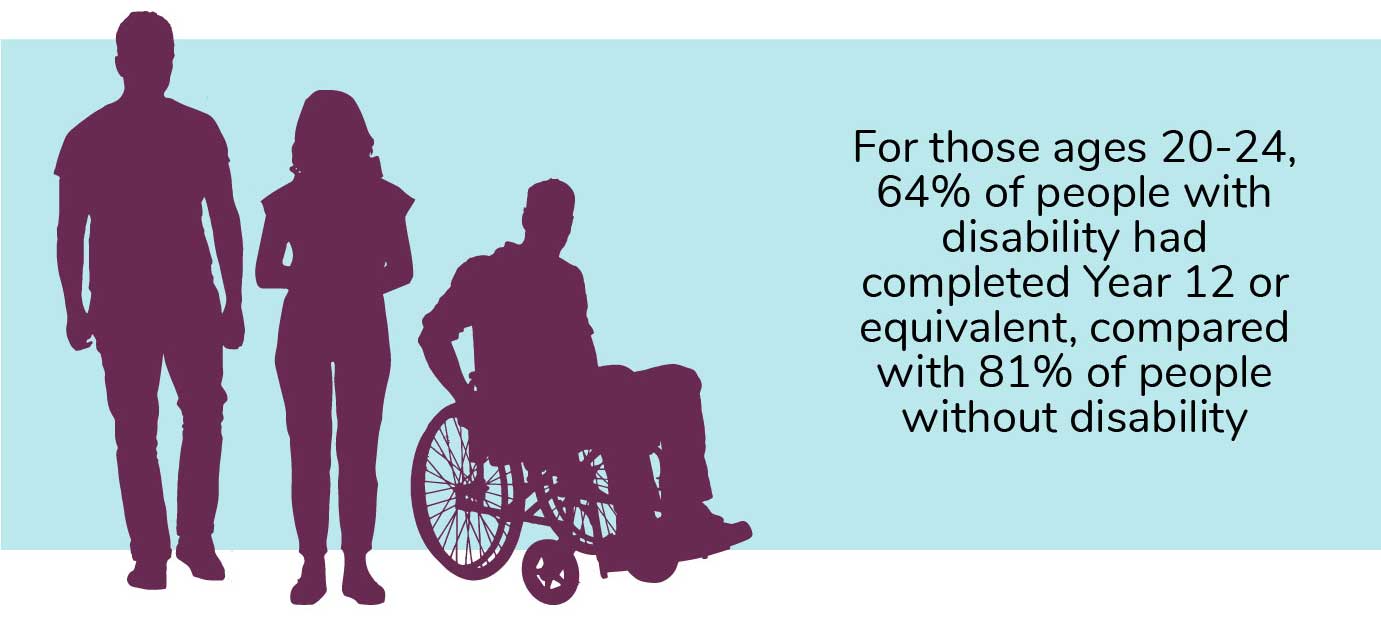
Source: Australian Institute of Health and Welfare, People with Disability in Australia, n.d. https://www.aihw.gov.au/reports/disability/people-with-disability-in-australia/education-and-skills/educational-attainment/highest-level-of-education
FIGURE 2: GEOGRAPHICAL IMPACT ON EDUCATION ATTAINMENT RATES
Geography has a significant impact on completion rates.
Over 80% of 19 year olds living in a metropolitan region complete year 12 compared to 64% of those living in inner regional areas and only 40% for those living in very remote regions. Those living remotely who do complete year 12 are also far less likely to go onto tertiary education12.
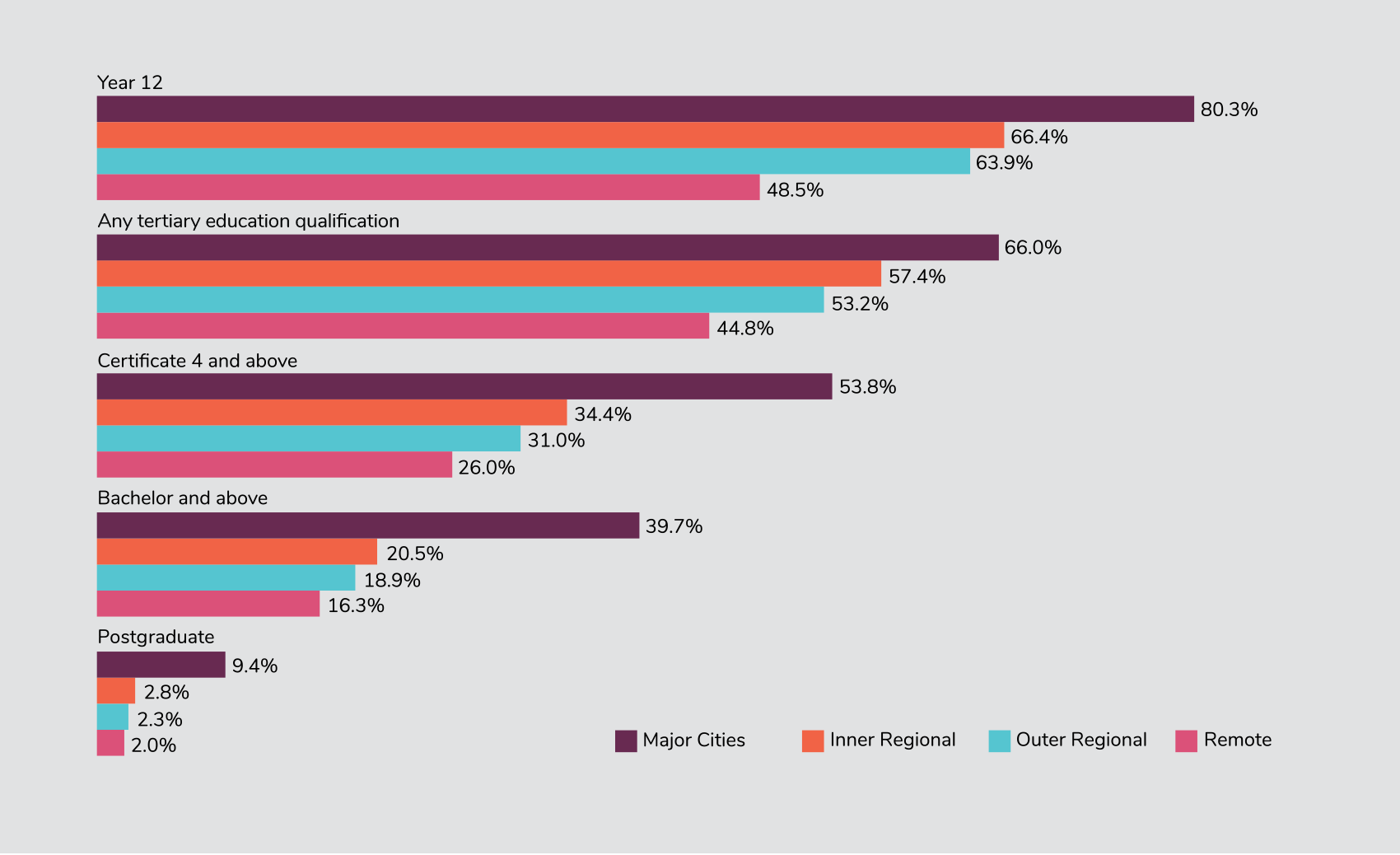
Source: © Commonwealth of Australia. Commonwealth Government (2019). National regional rural and remote tertiary education strategy: final report. Page 13. Year 12 rates are for people aged 19. Tertiary qualifications are for people aged 25-34 years. Remote includes Remote and Very Remote Categories. Any tertiary education qualification includes VET in Schools. Australian Bureau of Statistics (ABS) (2016) Census of Population and Housing.
FIGURE 3: RELATIONSHIP BETWEEN SES (DECILE) AND THOSE FULLY ENGAGED IN EDUCATION, TRAINING OR WORK AT AGE 24
There is a strong relationship between socioeconomic status and the percentage of those fully engaged in education, training or work at 2413.
Young people from less financially secure homes are much less likely to be fully engaged.
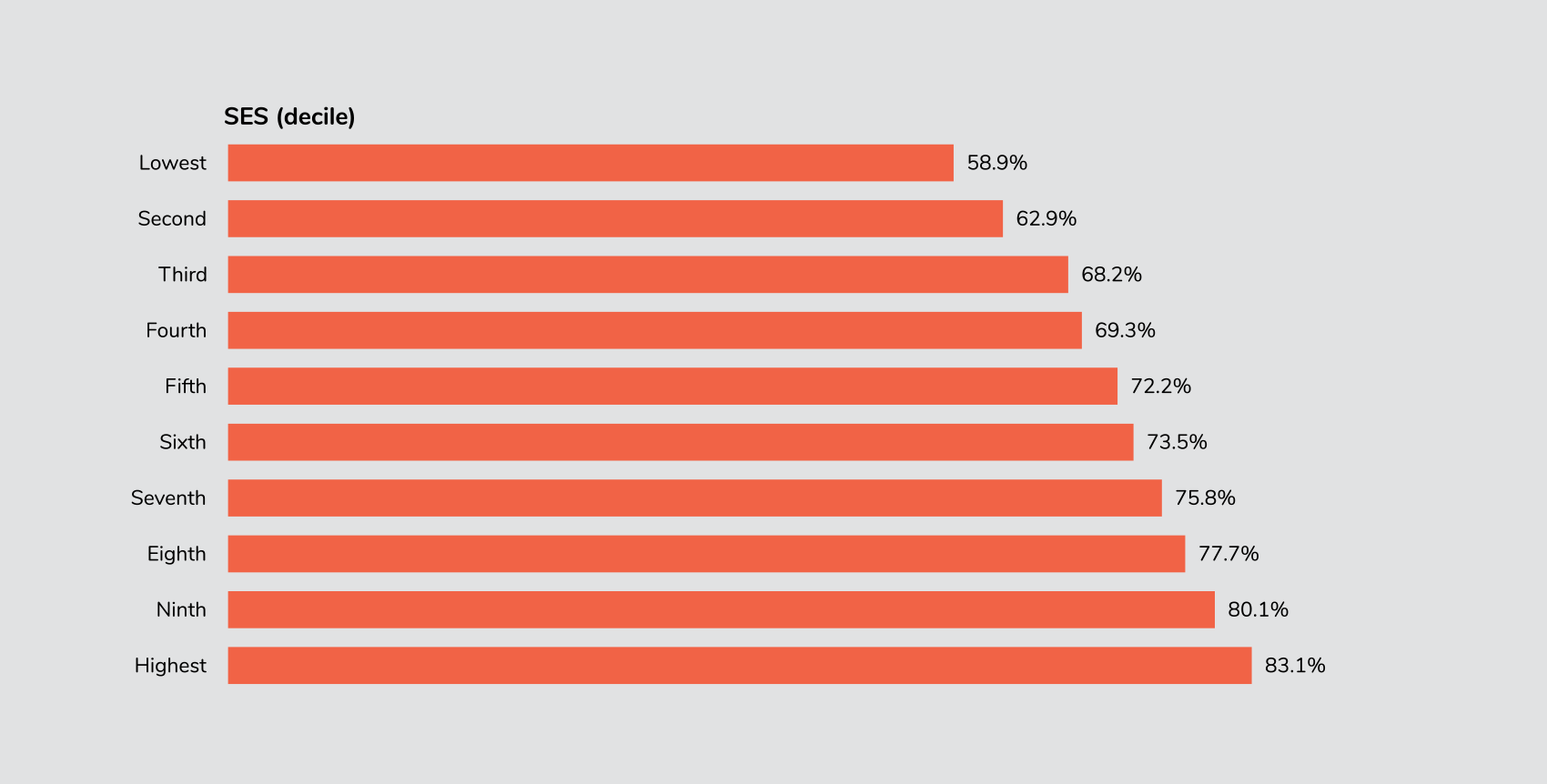
Source: Taken from Lamb, S., Jackson, J., Walstab, A. & Huo, S. (2015), Educational opportunity in Australia 2015: Who succeeds and who misses out? Centre for International Research on Education Systems, Victoria University, for the Mitchell Institute
FIGURE 4: ABORIGINAL AND TORRES STRAIT ISLANDER YOUNG PEOPLE FULLY ENGAGED IN EDUCATION, TRAINING OR WORK AT AGE 24
Only 41% of young people who identify as Aboriginal and/or Torres Strait Islander are fully engaged in education, training or work at 24 compared to 74 % of non-indigenous young people.14
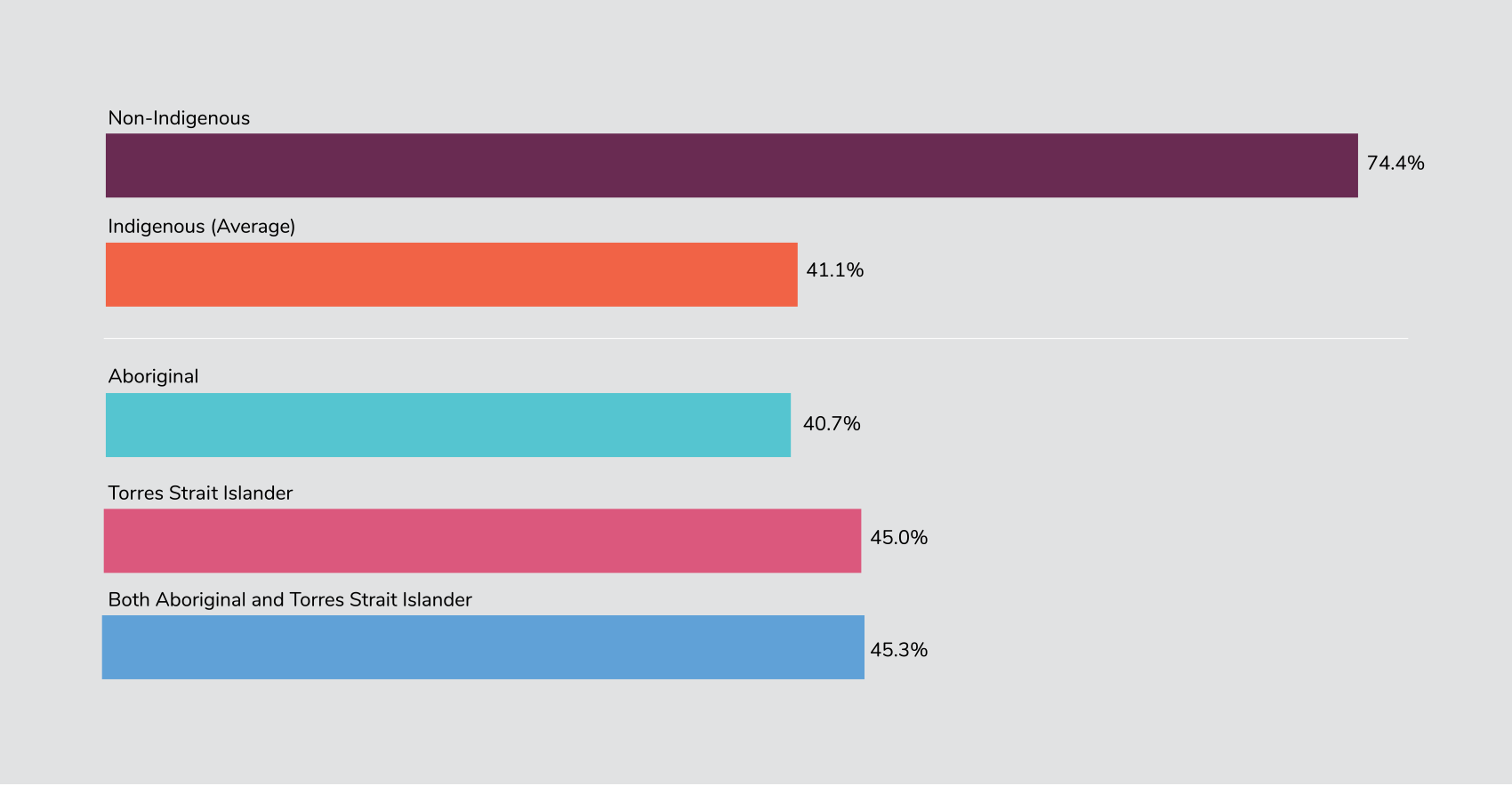
Source: Taken from Lamb, S., Jackson, J., Walstab, A. & Huo, S. (2015), Educational opportunity in Australia 2015: Who succeeds and who misses out? Centre for International Research on Education Systems, Victoria University, for the Mitchell Institute
BARRIERS TO SUCCESS
The current measures of success are causing barriers to excellence rather than leading to excellence in learning outcomes and may be having a negative impact on the mental and emotional health of young Australians.
1 in 3
27.4%
Discover more
The competitive nature of the ATAR and reliance on written examinations is unproductive and has encouraged gaming behaviour17.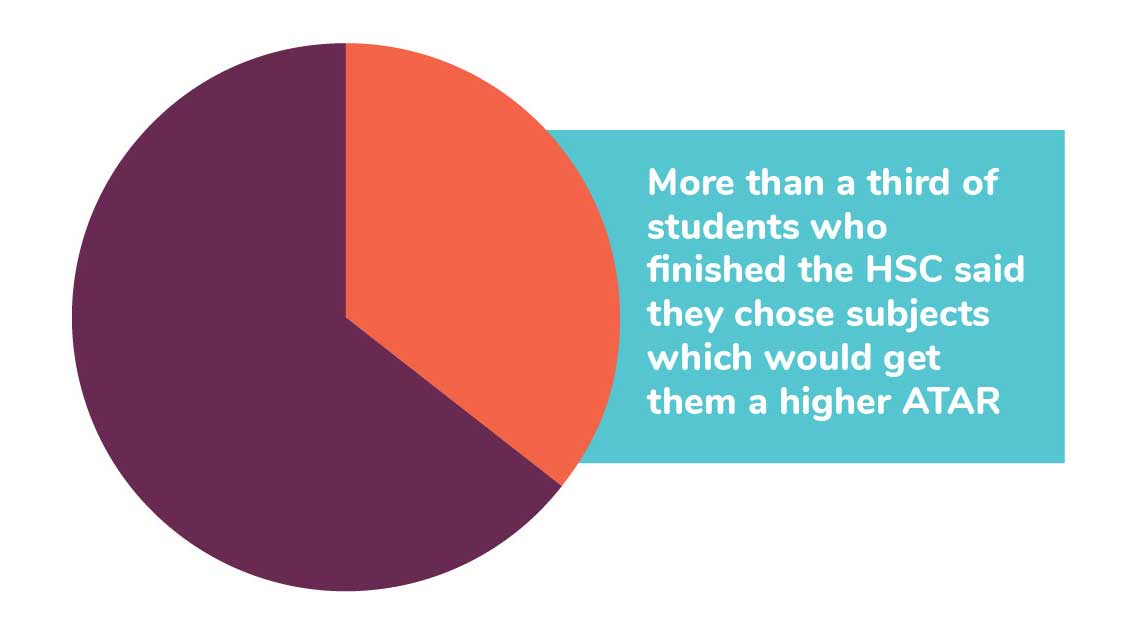
THE TRANSITION TO WORK
Following formal education, young people’s expectation to receive a tertiary qualification is decreasing18. And their transition into work is becoming increasingly long, difficult and stressful.
1 in 5
2.6 yrs
60%
$790M
Discover more
Over 70% of teachers are reporting students avoiding work and over 60% being deliberately disruptive on a daily basis. This makes it harder for teachers to teach and likely reduces the amount of learning going on in classrooms.
Our secondary school completion rates are low with one in five students failing to complete Year 12 nationwide. This varies significantly by state with only one in two young people completing Year 12 in the Northern Territory compared to almost 98% in the ACT27.
There is also a decline in the number of school leavers who are fully engaged in education, training and/or employment across all states and territories28.
There is a noticeable gap between young people’s job aspirations and the realities of the job market.
One third of 15 year olds are aspiring to jobs that are unlikely to exist in the future29 and there are high numbers of young people wanting to work in occupations where there are few opportunities.
Young people’s knowledge of the type of work that will be available to them is unrealistic and is worrying if they then invest time and energy in training for jobs that they are unlikely to be employed in or are likely to be automated before they finish training.
FIGURE 7: Australian 15 year-old students' motivation to achieve
On average, Australian 15-year-old students’ motivation levels to achieve are significantly higher than the OECD averages22.
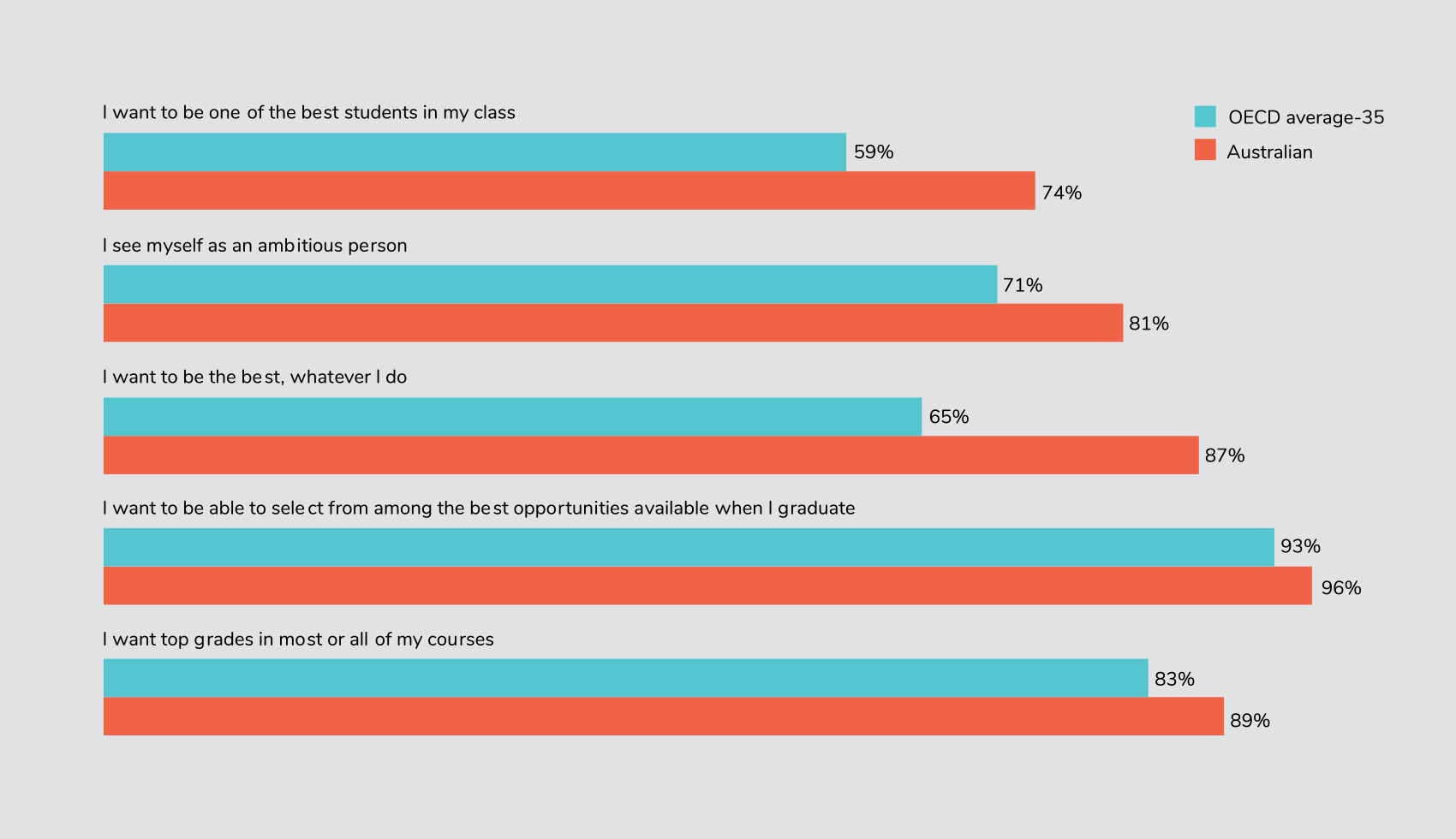
Source: Underwood, C. (2018). PISA Australia in Focus Number 3: Motivation. Australian Council for Educational Research (ACER). https://research.acer.edu.au/ozpisa/32
FIGURE 8: AUSTRALIAN 15 YEAR-OLD STUDENT’S EXPECTATIONS ABOUT THE LEVEL OF EDUCATION THEY WILL ACHIEVE
However, one third of young people are aspiring to jobs that won’t exist in the future and there is a high interest in occupations where there are limited positions available23. This suggests young people are finding it hard to see a link between their education and future work opportunities and could indicate why 40% of young people are disengaged at school24, 1 in 5 aren’t completing year 12 and fewer have expectations to go on to further study.
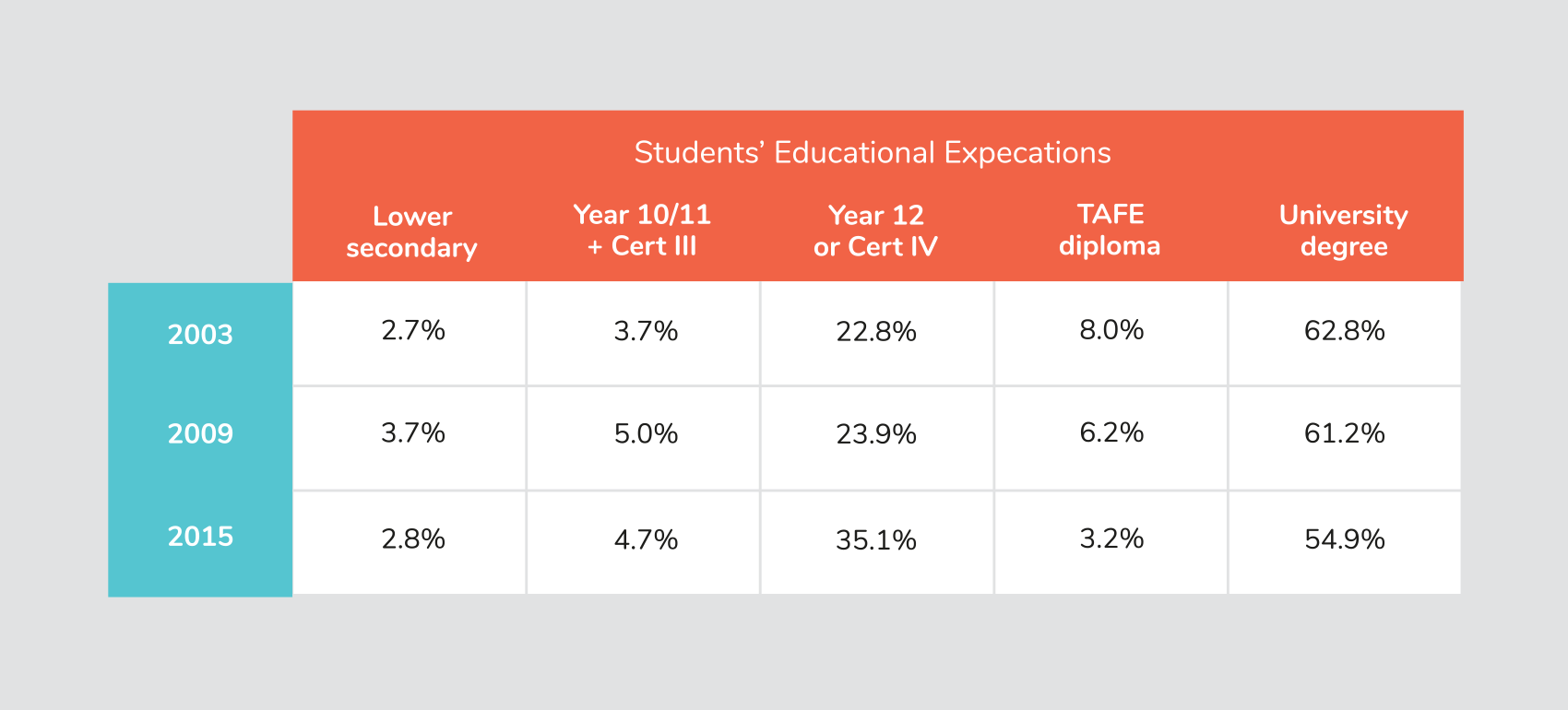
Source: Hillman, K. (2018). PISA Australia in Focus Number 2: Educational expectations. Australian Council for Educational Research. https://research.acer.edu.au/ozpisa/31
TOWARDS A NEW SOLUTION
We need a new way to recognise and assess learning in Australia so that all young people can develop and showcase the capabilities they need to access future opportunities.
There is growing recognition that if assessment, certification and recognition changes, so then does the curriculum, pedagogy and organisation of learning.
OUR FIRST PROJECT
Our first project The learner’s journey was identified as a key lever for change. It will unlock several solutions around new metrics and a better currency for recognising learning that is trusted and understood by the community and has social and economic currency.
To do this, Learning Creates will coordinate a national Social Lab - bringing people together from different sectors and communities around Australia to ensure our approach is relevant at a national scale.
CONNECT & CONTRIBUTE
Get involved
Sign up
Glossary of Terms
Australian Tertiary Admission Rank (ATAR) - Is a number between 0.00 and 99.95 that indicates a student’s position relative to other students their age. It is not a mark, but a rank that tertiary education facilities use to help them select students for admission into their courses and programs.
Curriculum - Outlines what every student should learn during their schooling, it is a common set of knowledge and skills required by students.
Enterprise Skills - Are transferable skills such as problem solving, communication, teamwork, and creativity.
Evidence-based - An approach that relies on knowledge gained through research to deduce arguments or guide decisions rather than relying on opinion or intuition.
Pedagogy - the method and practice of imparting knowledge and skills for learning
Secondary Education - Refers to the 6 years of schooling that come after primary education and generally take place between twelve and eighteen years of age. Secondary education most commonly takes place within a secondary school, often referred to as high school.
Socioeconomic status (SES) - refers to the social and economic position of a given individual, or group of individuals, within the larger society. The ABS defines ‘relative socioeconomic advantage and disadvantage in terms of people’s access to material and social resources, and their ability to participate in society’ (ABS, 2008, p. 5).
Tertiary Education - Refers to postsecondary education. Australian tertiary education can be divided into two sectors, Vocational Education and Training (VET) and Higher Education.
Vocational Education and Training (VET) - Is a qualification designed with the specific goal of preparing students with skills for work. Sometimes also referred to as career or technical education it supports students to join or rejoin the workforce, move into a new career or gain additional skills in their existing career.References
- © State of Victoria (Department of Education and Training). Australian Government, Department of Education, Skills and Employment, The Alice Springs (Mparntwe) Education Declaration (2019). Available at: https://docs.education.gov.au/documents/alice-springs-mparntwe-education-declaration
- Foundation for Young Australians, New Work Reality (2018). Available at: https://www.fya.org.au/report/the-new-work-reality/
- The Australian Industry Group, Skilling: A National Imperative (2018). Available at: https://cdn.aigroup.com.au/Reports/2018/Survey_Report_WFDNeeds_Skilling_Sept2018.pdf
- Deloitte Access Economics, Soft skills for business success (2017). Available at: https://www2.deloitte.com/au/en/pages/economics/articles/soft-skills-business-success.html
- Trading Economics, Australia Youth Unemployment Rate (2020). Available at: https://tradingeconomics.com/australia/youth-unemployment-rate
- Australian Bureau of Statistics, 5518.0.55.001 - Government Finance Statistics, Education (2016-17)
- The Australian Industry Group, Skilling: A National Imperative (2018). Available at: https://cdn.aigroup.com.au/Reports/2018/Survey_Report_WFDNeeds_Skilling_Sept2018.pdf
- Foundation for Young Australians, New Work Basics (2016). Available at: https://www.fya.org.au/report/the-new-basics/
- Foundation for Young Australians, New Work Basics (2016). Available at: https://www.fya.org.au/report/the-new-basics/
- Deloitte Access Economics, Soft skills for business success (2017). Available at: https://www2.deloitte.com/au/en/pages/economics/articles/soft-skills-business-success.html
- Australian Institute of Health and Welfare, People with Disability in Australia, n.d. Available at: https://www.aihw.gov.au/reports/disability/people-with-disability-in-australia/education-and-skills/educational-attainment/highest-level-of-education
- Commonwealth Government (2019). National regional rural and remote tertiary education strategy: final report. Page 13. Year 12 rates are for people aged 19. Tertiary qualifications are for people aged 25-34 years. Remote includes Remote and Very Remote Categories. Any tertiary education qualification includes VET in Schools. Australian Bureau of Statistics (ABS) (2016) Census of Population and Housing.
- Taken from Lamb, S., Jackson, J., Walstab, A. & Huo, S. (2015), Educational opportunity in Australia 2015: Who succeeds and who misses out? Centre for International Research on Education Systems, Victoria University, for the Mitchell Institute, Melbourne. Page 71.
- Taken from Lamb, S., Jackson, J., Walstab, A. & Huo, S. (2015), Educational opportunity in Australia 2015: Who succeeds and who misses out? Centre for International Research on Education Systems, Victoria University, for the Mitchell Institute, Melbourne. Page 71.
- Financial Review, May 29 2018.
- Mission Australia (2017). Youth Mental Health Report: Youth Survey 2012-2016. Page 12.
- Mission Australia (2017). Youth Mental Health Report: Youth Survey 2012-2016. Page 12.
- Australian Council for Educational Research (ACER). (2018). PISA Australia in Focus Number 2: Student Expectations. Page 10.
- Federal Department of Employment, Skills, Small and Family Business (2018). Employer perspectives on recruitment difficulty. Available at: https://cica.org.au/wp-content/uploads/Employer-perspectives-on-recruitment-difficulty-2018.pdf
- Foundation for Young Australians, New Work Reality (2018). Available at: https://www.fya.org.au/report/the-new-work-reality/
- Foundation for Young Australians, New Work Reality (2018). Available at: https://www.fya.org.au/report/the-new-work-reality/
- Australian Council for Educational Research (2018). PISA Australia in Focus Number 3: Motivation. Page 7.
- Baxter, J. The career aspirations of young adolescent girls and boys. LSAC Annual Statistical Report 2016 (2017). Available at: https://growingupinaustralia.gov.au/research-findings/annual-statistical-report-2016/career-aspirations-young-adolescent-boys-and-girls
- Grattan Institute, Engaging Students: Creating Classrooms that improve learning (2017)
- Ramsay & Rowan, (2017). Years 9-12 Education in Tasmania: A Response to the ACER Review. Table 3: Year 12 certificates and ATARs as a percentage of the Year 12 cohort. Notes: Year 12 cohort calculated as one fifth of 15-19 year olds, in accordance with COAG protocol. Population data from Available at: http://www.abs.gov.au/AUSSTATS/abs@.nsf/DetailsPage/3101.0June
- Foundation for Young Australians, New Work Reality (2018). Available at: https://www.fya.org.au/report/the-new-work-reality/
- Ramsay & Rowan, (2017). Years 9-12 Education in Tasmania: A Response to the ACER Review. Table 3: Year 12 certificates and ATARs as a percentage of the Year 12 cohort. Notes: Year 12 cohort calculated as one fifth of 15-19 year olds, in accordance with COAG protocol. Population data from http://www.abs.gov.au/AUSSTATS/abs@.nsf/DetailsPage/3101.0June
- Productivity Commission (n.d.) Available at: https://performancedashboard.d61.io/education/education_participation
- Schleicher, A. (n.d.) Dream jobs? Teenagers’ career aspirations and the future of work. Available at: https://www.oecd.org/education/dream-jobs-teenagers-career-aspirations-and-the-future-of-work.htm Taken from slide 8. Based on data from PISA 2015
- Foundation for Young Australians, New Work Reality (2018). Available at: https://www.fya.org.au/report/the-new-work-reality/
- Foundation for Young Australians, New Work Reality (2018). Available at: https://www.fya.org.au/report/the-new-work-reality/

